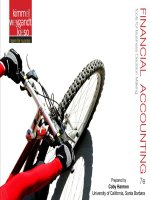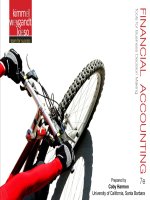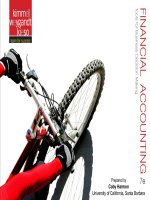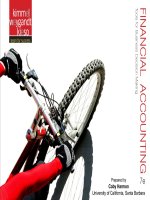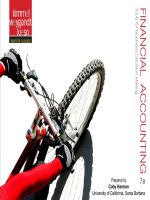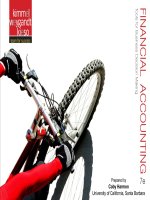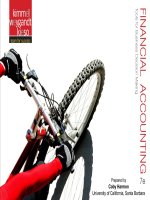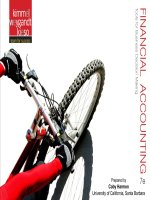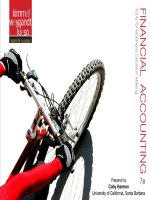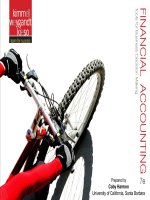accounting for business decision making january 2022 semester
Bạn đang xem bản rút gọn của tài liệu. Xem và tải ngay bản đầy đủ của tài liệu tại đây (634.96 KB, 15 trang )
<span class="text_page_counter">Trang 1</span><div class="page_container" data-page="1">
<i><b>HOCHIMINH CITY UNIVERSITY OF TECHNOLOGY</b></i>
</div><span class="text_page_counter">Trang 2</span><div class="page_container" data-page="2">Ho Chi Minh City, 2022
</div><span class="text_page_counter">Trang 4</span><div class="page_container" data-page="4"><b>Task 1: CLO3 a. Sales BudgetSales Budget</b>
<b>b. Production Budget</b>
<b>Production Budget</b>
<b>c. Direct Materials BudgetDirect Materials Budget</b>
Required in production of TX7 32,500 19,500 6,500Required in production of TX9 16,800 12,600 -Total direct materials needed in production 49,300 32,100 6,500
</div><span class="text_page_counter">Trang 5</span><div class="page_container" data-page="5">Add: Ending inventory 3,600 3,200 700Total direct materials needed 52,900 35,300 7,200
Purchase of direct materials in units 49,700 32,400 6,600
Budgeted cost of direct materials purchases 397,600 162,000 19,800 579,400
<b>d. Direct Labor BudgetDirect Labor Budget</b>
Total direct labor hours needed 13,000 12,600
Budgeted direct labor cost $156,000 $201,600 $357,600
</div><span class="text_page_counter">Trang 6</span><div class="page_container" data-page="6"><b>Cash Budget</b>
<b>For the quarter ending December 31, 2021</b>
Add: Cash collected from customers
Less: Cash disbursements
Purchase of direct materials 579,400
Selling and administrative overhead 25,000
<b>Task 3 (CLO2)Solution:</b>
Breakeven analysis, also termed as Cost, Volume and Profit (CVP) analysis is a short-termmanagerial decision making technique. The analysis aims to estimate profit for changes in costsand volume. Breakeven point is the point at which the total revenues equal total costs, whichresults in no-profit, no-loss situation.
All sales above breakeven point result in profit and sales below breakeven point result in loss.Queenie Cocoa
<b>1. Contribution margin income statement:</b>
</div><span class="text_page_counter">Trang 7</span><div class="page_container" data-page="7"><b>For the First Year of Operations</b>
Selling and administrative overhead <sup>$126,000</sup>
Fixed costs:
Selling and administrative overhead <sup>$120,000</sup>
Hence, net income for the first year of operations is $168,000.
<i><b>Computations and explanation:</b></i>
Sales = number of units sold x sales price per unitNumber of units sold = 42,000
Sales price per unit = $40Sales = $40 x 42,000 = $1,680,000Variable costs –
</div><span class="text_page_counter">Trang 8</span><div class="page_container" data-page="8">Direct materials at $12 per unit = $12 x 42,000 = $504,000Direct labor at $6 per unit = $6 x 42,000 = $252,000
Manufacturing overhead at $5 per unit = $5 x 42,000 = $210,000Selling and admin overhead at $3 per unit = $3 x 42,000 = $126,000Contribution margin = sales – total variable cost
Contribution margin = $1,680,000 – $1,092,000 = $588,000
b) Calculate Queenie's break-even point in units and dollars.
Breakeven point in units = 30,000Breakeven point in Dollars = $1,260,000Computations and explanation –
Breakeven point in units = fixed cost/contribution margin per unit
Total fixed cost = fixed manufacturing overhead + fixed selling and admin overheadTotal fixed cost = $300,000 + $120,000 = $420,000
Contribution margin per unit = total contribution margin/units soldTotal contribution margin = $588,000
Contribution margin per unit = $588,000/42,000 units = $14Now, breakeven point in units = $420,000/$14 = 30,000 unitshence, the company should sell 30,000 units to breakeven.Breakeven point in Dollars –
Breakeven point in Dollars = fixed costs/CM ratioTotal fixed cost = $420,000
CM ratio = CM/sales
CM ratio = ($588,000/$1,680,000) x 100 = 33.33%Breakeven point in Dollars = $420,000/33.33% = $1,260,000
</div><span class="text_page_counter">Trang 9</span><div class="page_container" data-page="9">Assuming tax rate – 40%; compute margin of safety in units at this point:
The number of units that Queenie must sell to achieve an after-tax profit of $210,000 – 55,000 units
<b>Computations and explanation:</b>
Desired units = (Target profit before tax + Fixed cost)/CM per unitTarget profit before tax = After-tax profit/(1-Tax rate)
After tax profit = $210,000Tax rate = 0.40
Target profit before tax = $210,000/(1-0.40)Target profit before tax = $210,000/0.60 = $350,000Total fixed cost = $420,000
CM per unit = $14
Desired units = ($350,000 + $420,000)/$14Desired units = $770,000/$14 = 55,000
Hence, desired units that Queenie must sell to achieve an after-tax profit target of $ 210,000 is 55,000.
<b>Margin of safety at this level:</b>
Margin of safety = actual sales – desired salesActual sales = 42,000 units
Desired sales = 55,000 units
Margin of safety = 42,000 – 55,000 = (13,000) unitsMargin of safety is negative at this level of units.
d. Calculation of new breakeven point in Dollars, assuming Queenie incurs additional selling expensesof $35,000:
new breakeven point in $ is $1,365,000
<b>Computations and explanation:</b>
Breakeven point in $ = total fixed cost/CM ratio
</div><span class="text_page_counter">Trang 10</span><div class="page_container" data-page="10">Hence, total fixed cost = $420,000 + $35,000 = $455,000Assuming all other costs remain constant,
CM ratio = $14/$40 = 33.333%
Breakeven units = $455,000/33.33% = $1,365,000Hence, new breakeven point in $ is $1,365,000.
e. Breakeven analysis is based on several assumptions. How do these limit the use of the analysis?
<i><b>Breakeven analysis is based on the following assumptions</b></i>
The selling price remains constant. The number of units produced equal the number of units sold,hence, there will be no beginning and ending inventory of units. The variable cost per unit remainsconstant and is directly proportional with sales.
The fixed cost remains constant in whole and is not affected by changes in sales volume.
The assumptions of breakeven analysis may not hold true in real-life scenarios.
The selling price may not be constant for all situations. The selling price may be affected by variousfactors such as supply-demand changes, market competition and market trends.
The variable and fixed costs may not be easily differentiated into clear-cut fixed and variablecomponents.
The total fixed cost is assumed to be constant for any given level of sales, but in reality, the fixed coststend to change beyond a specific of sales volume.
Also, the assumption that variable costs vary directly in proportion to the sales volume, which may notbe necessarily true in actual situations. The variable costs may not exactly vary in direct proportion tosales volume.
The breakeven analysis also assumes that the product mix remains constant, which may not happen inreal situations. The product mix may vary with changes in market conditions.
<b>Task 4: CLO1 </b>
Solution :The price $0.70
</div><span class="text_page_counter">Trang 11</span><div class="page_container" data-page="11">focus on favourable price variance. Therefore from the point de view of favourable pource variance,purchasing from news suppliers is right but simultaneously it is also need to verify the credibility ofsuppliers ke-quality of goods chettvered and future saturned option, ste. As in this case, experience andInformation indicate that rrecord and Information about the new supplier 78 not Satisfaetsy. sofavourable purice 98 meaningless as if there P8 possibility s bad quality and option of satwoned may beabsent while dealing with this supliere. SO, Explained above st is not ethical as decision taken byAssul.
<b>PART 2 (50%) Task 1: CLO3 </b>
a. Material price variance = (Standard Price – Actual Price) x Actual QuantityMaterial price variance = ($5 - $5.25) x 96,000 = $24,000 unfavourable (U)
b. Material usage variance = (Standard Quantity – Actual Quantity) x Standard PriceMaterial usage variance = (20 x 5000 unit - 96,000) x $5 = $20,000 favourable (F)Direct labourrate variance = (Standard Rate – Actual Rate) x Actual hours Direct labourrate variance = ($6 - $6.55) x 41,000 = $22,550 unfavourable (U)
d) Direct labour efficiency variance = (Standard hours – Actual hours) x Standard rate hours Direct labour efficiency variance = (8 hrs x 5000 – 41,000 hrs) x 6 = 6,000 unfavourable (U)e) Variable overhead spending variance = Actual Variable overhead – Standard Variable overhead ratex Actual hours
Variable overhead spending variance = $238,000 – $3 x 41,000 = $115,000 unfavourable (U)f) Variable overhead efficiency variance = (Standard hours – Actual hours) x Standard Variableoverhead rate
Variable overhead efficiency variance = (40,000 – 41,000) x $3 = $3,000 unfavourable (U)
<b>Task 2: CLO4 </b>
a.
</div><span class="text_page_counter">Trang 13</span><div class="page_container" data-page="13">Quick ratio for 2020 = = 1,82
Since Quick ratio has increased from 1.68 to 1.82 from 2019 to 2020, it means that company’s abilityto riquidate its assets instantly to pay off its current liabilities has increased.
c) Accounts receivable turnover (year 2019 -11.87) Accounts receivable turnover =
Average account receivables = = $768We have assumed sales to be net credit salesAccount receivables turnover for 2020 = = 14,81 timesAccount receivables turnover for 2019 = 11,87 times
Since Account receivables turnover has increased from 11,87 to 14,81 from 2019 to 2020, it means thecompany will new collect its average receivables in more time which is not a good sign.
d) Inventory turnover (year 2019 – 9.80) Inventory turnover =
Average Inventory = = $900
Inventory turnover for 2020 = = 12,64 times Inventory turnover for 2019 = 9,80 times
</div><span class="text_page_counter">Trang 14</span><div class="page_container" data-page="14">at which company can sell and replace its stock of good is higher in 2020 than that of 2019e) Debt ratio (year 2019 – 47.57%)
Debt ratio = x 100= x 100
Debt ratio for 2020 = x 100 = 43,65%
Note: We have assumed non current liabities consiste of only long term debt and current liabitiesconsist of only short term debt
Debt ratio for 2019 = 47.57%
Since debt ratio has decreased from 47.57% in 2019 to 43,65% in 2020 it indicates that the proportionof company’s asset finaneed by debt has decreased
f) Return on assets (year 2019 – 1.40%) Return on assets = x 100
Return on assets for 2020 = x 100 = 18,28%Return on assets for 2019 = 1,40%
Since Return on assets has significantly inurased from 1,40% in 2019 to 18,28% in 2020, it meansthat company’s management has been efficiently using total asset of company to generate morecarnings.
g) Profit margin (year 2019 – 1.00%) Profit margin = x 100
Profit margin for 2020 = x 100 = 9.85%Profit margin for 2019 = 1,00%
Since, profit margin has increased significantly from 1,00% in 2019 to 9,85% in 2020 oit meansthat company can generate more profit from its sales in 2020 as copared to 2019.
h) Return on common stockholders' equity (year 2019 – 2.68%)
</div><span class="text_page_counter">Trang 15</span><div class="page_container" data-page="15">Return on common stockholders' equity for 2019 = 2,68%
Since, Return on common stockholders' equity has increase significantly from 2,68% to 32,44%from 2019 to 2020 it means that company is generating more return on investment receivedfrom common stockholders in 2020 as conpared to 2019.
</div>